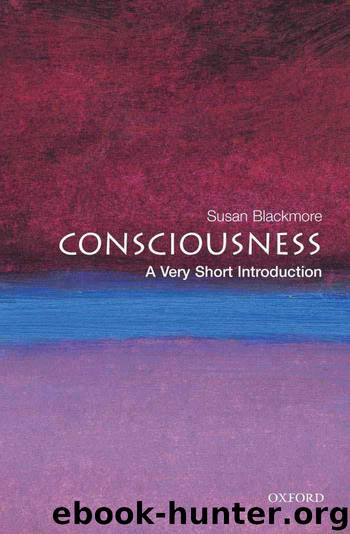Consciousness - A Very Short Introduction by Susan Blackmore

Author:Susan Blackmore
Language: eng
Format: mobi, epub
Published: 2010-10-28T16:58:32.281000+00:00
Chapter 6 Conscious will
Do we have free will?
Hold out your hand in front of you and – whenever you feel like it, and of your own free will – flex your wrist.
Did you do it? If not you must have decided against bothering. Either way, you made a decision. You flipped your hand at a certain moment, or you did not do it at all. Now the question is, who or what made the decision or initiated the action? Was it your inner self? Was it the power of consciousness? This is the way it feels but, as we have seen, there are serious problems with the idea of an inner self, and even if an inner self does exist, we have no idea how it could make the action happen. So perhaps there were just a lot of brain processes, following one after another, that determined whether and when you flexed your wrist.
This certainly fits with the anatomical evidence. Much is known about the control of voluntary actions from experiments on both humans and other animals. When any voluntary act is carried out, such as flexing the wrist, many areas of the brain are involved. Roughly, the sequence is something like this: activity begins in the prefrontal region which sends connections to the premotor cortex. This programmes the actions, and sends connections to the primary motor cortex. The motor cortex then sends out the instructions that move the muscles.
18. Brain areas involved in volition. When making a volitional act, neural activity flows from prefrontal areas through premotor and motor cortex. Other areas marked here may also be involved. Where is the need for consciousness to intervene? How and where could an inner self act?
Other areas are involved in specific actions. For example, in speech, Broca’s area produces the motor output and, in most right-handed people, is in the left hemisphere. Then there is the supplementary motor area which deals with the precise sequencing and programming of preplanned actions, and the anterior cingulate which is involved in attending to emotions and pain as well as action. Finally, evidence from brain scans in humans shows that an area called the dorsolateral prefrontal cortex is uniquely associated with the subjective experience of deciding when and how to act.
So the problem is this. Science can reveal which neurons are active as sensory information comes in, and when actions are planned and carried out. Yet deciding to act doesn’t feel like neurons firing, whether in the prefrontal cortex or anywhere else. It feels as though there is something else – my self, my consciousness – that makes me free to respond the way I want.
This is the classic problem of free will. David Hume called the problem of free will the most contentious of metaphysics. Indeed, it is said to be the most discussed problem in all of philosophy, going back to the ancient Greeks and beyond. The issue raises strong feelings because freedom implies responsibility. We consider ourselves responsible, and we hold others accountable for their actions on the assumption that they freely chose to act the way they did.
Download
Consciousness - A Very Short Introduction by Susan Blackmore.epub
This site does not store any files on its server. We only index and link to content provided by other sites. Please contact the content providers to delete copyright contents if any and email us, we'll remove relevant links or contents immediately.
When Breath Becomes Air by Paul Kalanithi(7278)
Why We Sleep: Unlocking the Power of Sleep and Dreams by Matthew Walker(5667)
Paper Towns by Green John(4179)
The Immortal Life of Henrietta Lacks by Rebecca Skloot(3835)
The Sports Rules Book by Human Kinetics(3601)
Dynamic Alignment Through Imagery by Eric Franklin(3504)
ACSM's Complete Guide to Fitness & Health by ACSM(3475)
Kaplan MCAT Organic Chemistry Review: Created for MCAT 2015 (Kaplan Test Prep) by Kaplan(3431)
Introduction to Kinesiology by Shirl J. Hoffman(3308)
Livewired by David Eagleman(3139)
The River of Consciousness by Oliver Sacks(3000)
Alchemy and Alchemists by C. J. S. Thompson(2918)
The Death of the Heart by Elizabeth Bowen(2911)
Descartes' Error by Antonio Damasio(2748)
Bad Pharma by Ben Goldacre(2738)
The Gene: An Intimate History by Siddhartha Mukherjee(2502)
Kaplan MCAT Behavioral Sciences Review: Created for MCAT 2015 (Kaplan Test Prep) by Kaplan(2495)
The Fate of Rome: Climate, Disease, and the End of an Empire (The Princeton History of the Ancient World) by Kyle Harper(2444)
The Emperor of All Maladies: A Biography of Cancer by Siddhartha Mukherjee(2440)
